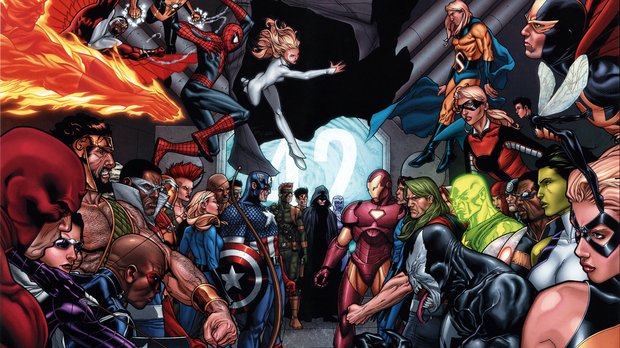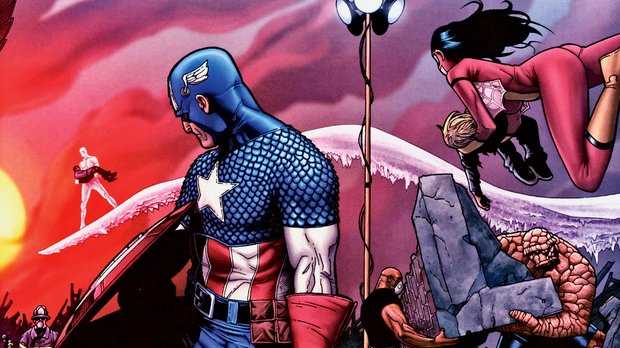Mark Millar talks about the comic book origins of Captain America: Civil War
It’s been described as “Marvel’s equivalent to Watchmen” in terms of sales figures but Mark Millar never suspected that the Civil War comic would become such a huge phenomenon when he began writing the seven-issue miniseries just over a decade ago. Pitting the government-aligned forces of Iron Man against a rebellious Captain America and his allies, the Steve McNiven-drawn crossover was initially designed as simply 2006’s answer to event books like Secret Invasion or Fear Itself.
But after becoming the biggest seller of that year, the collected edition has since become one of Marvel’s biggest selling graphic novels ever, shifting over half a million copies to date and still ranking as Marvel’s top-selling trade paperback in 2015. Now set to spawn its own comic book sequel in May in the form of Brian Michael Bendis and David Marquez’s Civil War II, it also forms the basis of this April’s movie Captain America: Civil War, which will see the Marvel Cinematic Universe’s Sentinel of Liberty Chris Evans coming to blows with Robert Downey Jr’s big screen Shellhead.

“When Steve and I were first doing it, we didn’t think that it would be as enormous as it has turned out to be,” says Millar. “We just thought it would be our summer event because Brian Bendis and Olivier Coipel had already done House Of M, and it was kind of our turn to do one. We just thought it would be lovely if it did well, so we were delighted when it caught on. We knew something funny was happening when the orders for the first issue came in. By the time you count up all the variant covers, it would have done around 450,000 copies.”
Now known for his creator-owned Millarworld series like Kick-Ass, Wanted and The Secret Service, which have given rise to their own Hollywood blockbusters, the bulk of Millar’s Marvel output prior to Civil War had been confined to the offshoot Ultimate universe. Having reinvigorated the concept of the Avengers in his seminal run on Ultimates alongside Bryan Hitch, he also enjoyed stints on Ultimate X-Men and Ultimate Fantastic Four. However, Civil War presented Millar with an opportunity to have a similarly seismic impact upon the House of Ideas’ main superhero universe. First pitched by him at one of Marvel’s regular creative summits, it actually grew out of a potential storyline he had devised for the Merry Mutants.
“We just sat around for three days and, as we always do at these things, we spent the first couple of days plotting everything out and then chatting about it,” he recalls. “A couple of the guys had an idea for a crossover but we just didn’t really like the sound of it. You hate to be the guy who complains that something isn’t working but I could see it in the other guys’ faces, as it was a good story but it just didn’t seem right for a big company crossover. I’d had this idea for a civil war among the X-Men, which Bryan Hitch and I were going to follow up Ultimates with.”

Covering similar territory to 2011’s similarly divisive Schism storyline, X-Men: Civil War would have seen Wolverine and Cyclops falling out over the future direction of mutantkind. However, Hitch’s unavailability prompted a rethink. “Bryan was taking longer on Ultimates than expected and he wasn’t going to be ready until around 2007,” continues Millar. “But I still wanted him to draw it, so I said ‘why don’t we leave the X-Men out of this and do Civil War as a big summer event?’ [Fellow Marvel writer] Jeph Loeb then came up with this really great catchphrase, which was ‘Whose side are you on?’ and Civil War ended up becoming a more Avengers-centred event, although I never ended up doing that X-Men crossover, as I then went off and did Kick-Ass.”
Both founding members of the Avengers but polar opposites as characters, Iron Man and Captain America made for natural figureheads to head up the rival factions. “One represents the past and one represents the future, but they both represent America,” reasons Millar. “If you think about it, Tony Stark’s entire business model is based on anticipating future trends, as to where America and the world is going, while Steve Rogers was born when your grandfather was born. So it seemed obvious that they would clash when it came to where to take the team next, which would probably be in very different directions.”
Get sneak previews, exclusive competitions and details of special events each month!

While Steve Rogers has sometimes been perceived as a glorified political lackey, Millar believes he’s always been a considerably more independent spirit than often given credit for. “There’s this criticism where people sometimes think of Cap as this guy who follows the government line, but ultimately Captain America is a symbol of freedom,” he says. “He doesn’t represent the government, as much as he represents an idea. He follows the flag; he doesn’t follow the particular president as such. So Cap would be kind of romantic and say, ‘We can’t work for the government, we have to be free agents like the Lone Ranger.’ Whereas Tony Stark would think, ‘Well, at the same time, we can’t have the Avengers running around and knocking down buildings without a licence.’ That led some people to think that the series was about secret identities, but it wasn’t really to do with that. It was more about, ‘Should superheroes work for the government or not?’ and that idea was encapsulated in Captain America and Iron Man.”
The misapprehension that Civil War explores the subject of superhero aliases perhaps stems from #2’s dramatic climax, which sees Spider-Man sensationally revealing on live TV that he is actually Peter Parker. “When you do a large event like that, you have to do something really big and we knew that there was a Spider-Man story coming up, where he was sort of going to be rebooted, so we kind of had a licence to do anything we liked with him,” says Millar, referring to 2007’s controversial “One More Day”, which erased numerous elements of the Wall-Crawler’s personal life, including his marriage to Mary Jane Watson. “But it’s funny that it received so much attention because in the book itself it only takes up three or four panels.”

Introduced after a New Warriors operation in the small town of Stamford Connecticut goes horribly wrong, culminating in an explosion that kills dozens of people, the Superhero Registration Act requires all superpowered individuals to sign on with the authorities, which Millar maintains wouldn’t necessarily be a bad thing. “Weirdly, some of the other writers would often make Tony the bad guy, which I thought was a strange choice because I was actually on Tony’s side,” he says, referring to the various spin-off titles that accompanied the main series. “In the real world, if somebody had superpowers, I’d like them to be registered in the same way that somebody who has a gun has to carry a licence. But a gun can kill several people while a superhero can kill several thousands of people, so on a pragmatic level I’m 100% on Tony’s side. Maybe on a romantic level, Cap’s position makes sense but I don’t think anybody in the real world would really want that.”
With the exception of a new incarnation of the Thunderbolts, which saw the likes of Bullseye, Taskmaster and Lady Deathstrike press-ganged by Iron Man to track down the renegade Captain America and friends, the bad guys take a backseat for the majority of Civil War, a move that suited Millar, who preferred DC Comics as a child. “I read Marvel when I was very young, so I have a broad understanding of the main characters,” he says. “So I just made it about the guys that I knew, which just happened to be the heroes. I’m not all that familiar with the Marvel villains, and the ones that do appear are essentially Spider-Man’s and maybe the Fantastic Four’s as well.”
Ultimately Millar argues that Civil War was actually just an extension of the obligatory slugfest that usually occurs whenever two superheroes first meet before they eventually unite against a common foe. “I always thought it was a traditional comic because the Marvel comics that I did read as a kid always seemed to be Thor vs the Hulk, or the Hulk vs Spider-Man,” he says. “There always seemed to be these titanic battles, and you’d always have two heroes going off at one another. I always saw that as a very Marvel thing, as you never really saw Green Lantern fighting the Flash or whoever. DC always seemed to be more grown up and ‘yes, we’ll work together on this problem,’ while the Marvel guys seemed to be quite teenage and aggressive. They were always meeting, having a misunderstanding, fighting and then becoming friends. It was just that classic structure, and I thought, ‘If I’m doing this as a big Marvel event then readers are going to want to see that on a grand scale.’”
Images: Marvel
Click here for more excellent SFX articles. Or maybe you want to take advantage of some great offers on magazine subscriptions? You can find them here.
Stephen is an entertainment journalist based in London. His bylines have appeared in the New Zealand Herald, SFX Magazine, GamesRadar, the Judge Dredd Magazine, and 2000AD Ultimate Collection.


